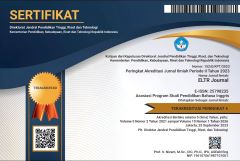WOMEN’S LANGUAGE FEATURES IN MICHELLE OBAMA’S SPEECH “THE FIRST LADY ON THE IMPORTANCE OF STUDYING ABROAD”
Abstrak terlihat: 512 / PDF terunduh: 459DOI:
https://doi.org/10.37147/eltr.v1i2.44Keywords:
women’s language feature, Michelle Obama’s speech, genderAbstract
The research entitled The Analysis of Women’s Language Features found in Michelle Obama’s Speech “The First Lady on the Importance of Studying Abroad” aims to identify women's language features based on Lakoff theory found in Michelle Obama’s speech. The data were collected using a descriptive qualitative method; the data were gathered by watching the video several times and reading the transcript of Michelle Obama's speech containing the women's language features on Youtube. The data were analysed by using Lakoff (1975) on women's language. The results of this research show that there are 89 items found, 18 items or 20% of lexical hedges or fillers, 1 item or 1% of rising intonation on declaratives, 13 items or 15% of intensifiers, and 57 items or 64% of emphatic stress.
Downloads
References
Ary, D., Jacobs, L.C., Sorensen, C., & Razavieh, A. (2010). Introduction to research in education (8th Ed.). Belmont, CA: Wadsworth Thomson Learning. pp. 419 – 511
Amanda, C.S. (2017). An analysis of the use of women’s language features by Hillary Clinton in Presidential Debates (Undergraduate’s thesis, Sanata Dharma University, Yogyakarta, Indonesia). Retrieved from http://library.usd.ac.id/.
Holmes, J. & N. Wilson. (2017). An introduction to sociolinguistics (5th Ed.) London: Routledge.
Lakoff, R. (1973). Language and woman's place. Language in society, 2(1), 45-79.
Lakoff, R. (1975). Language and woman’s place. New York: Harper Colophon.
Lakoff, R. (2004). Language and woman’s place: Text and commentaries. Oxford, NY: Oxford University Press.
Oktapiani, T., Natsir, M., & Setyowati, R. (2017). Women’s language features found in female character’s utterances in the Devil Wears Prada movie. Ilmu Budaya (Jurnal Bahasa, Sastra, Seni dan Budaya), 1(3), 220.
Pasaribu, T. (2017). Gender differences and the use of metadiscourse markers in writing essays. International Journal of Humanity Studies, 1(1). 1-13
Pasaribu, T.& Kadarisman, E. (2016). Coding logical mechanism and stereotyping in gender cyber humours. A Journal of Culture, English Language Teaching & Literature, 16, pp. 22-48. doi:10.24167/celt.v16i1.485.
Swerts, M, & Hirschberg, J. (2010). Prosodic predictors of upcoming positive or negative content in spoken messages. The Journal of the Acoustical Society of America, 128(3), 1337-1345.
Downloads
Published
How to Cite
Issue
Section
License
Copyright (c) 2017 Fidelia R.W. Wardani and Maria K.G. Kristiani

This work is licensed under a Creative Commons Attribution-ShareAlike 4.0 International License.













